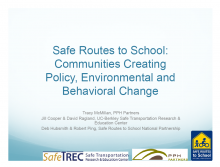We are pleased to announce an exciting new alliance between Active Living Research and GP RED to co-host and coordinate...
Safe Routes to School: Communities Creating Policy, Environmental and Behavioral Change

Presentation at the 2010 Active Living Research Annual Conference
Background:
The Safe Routes to School (SRTS) National Partnership’s Local School Project (LSP) is a community-driven SRTS effort in ten locations across the United States. The goal of the LSP is to help these sites to: 1) develop and evaluate a SRTS program, 2) build local capacity to apply for state or federal funding, and 3) increase safe walking and bicycling at the school and in the community.
The National Partnership identified ten schools in diverse, low-income communities in the winter of 2008. Schools were chosen based on school readiness and interest, available partners, availability of data, the built environment, and volunteer and staff capacity. Each location identified a local champion to manage project activities. Kaiser Permanente (KP) provided funds for a part-time coordinator to schools in four states in which they had a presence (VA, DC, GA and CA). These sites also received technical assistance from National Partnership staff. The six other locations (IL, OK, KY, NY, LA, TX) received technical assistance from the National Partnership, but no financial support. The evaluation team (TM, JC and DR, abstract co-authors) provided evaluation planning and technical support to all the sites.
Each local champion worked prior to and during the 2008-2009 academic year to promote SRTS. SRTS program activities could include engineering, enforcement, encouragement, and/or education. The local champions were also responsible for evaluation. They collected before data in spring or fall 2008 and after data in spring 2009. Data included parent surveys and student travel tallies (using National Center for SRTS forms). The four KP sites additionally conducted intersection observations and vehicle counts and held focus groups in fall 2008.
Objectives:
The overall objective of this presentation is to highlight the institutional elements that promote successful and sustainable SRTS programs. Specifically, this presentation will:
1) Examine the processes, challenges and successes of LSP programming and evaluation;
2) Identify differences in program planning and implementation, mode shift, policy change, and program sustainability that may exist between sites with and without paid coordinators;
3) Examine relationships between SRTS programs and reported rates of walking/biking.
Methods:
In June 2009, the evaluation team conducted phone interviews with eight of the ten sites (CA, GA, DC, VA, KY, NY, OK, IL). The interview team developed a questionnaire that included closed- and open-ended questions to inquire about successes, challenges and barriers related to program development, implementation, evaluation, institutionalization and sustainability at or involving the school. Interviews were conducted with the local champion and/or the state network coordinator.
Results:
62% of interviewees rated the project’s overall success as very high or high, while 38% were neutral. The local champion and school team were rated as critical in initiating SRTS planning at the school and achieving success. Other key players include local government staff, school administrators and volunteers. Six sites reported that school staff were the group most missing from the project. Several sites reported that while school administrators were engaged and helpful, they also acted as gatekeepers to teachers. Some sites noted the absence of neighborhood organizations and parents. Reported barriers to participation include pressure to improve test scores and address neighborhood crime. Accordingly, only 37% rated the project’s ability to bring together key partners in a sustainable committee as very high or high. Few differences were seen between the KP and non-KP sites.
Seven sites reported policy or environmental change as a result of the project (e.g., street closures near school, installation of bicycle racks, sidewalk repair). 87% lauded the project’s success in creating momentum toward policy change and/or changes in the built environment in the broader community. All locations had difficulty recruiting and sustaining volunteers, although the four KP sites were more successful. All of the locations experienced challenges in data collection.
In terms of sustainability, 63% stated that their school’s SRTS program is very likely/likely to continue in some capacity with no additional funding after the program ends, largely because of momentum from the past year’s activities. As a whole, the KP sites were less optimistic that the programs would continue at the same level without support, perhaps partially due to a higher overall level of activity throughout the year.
Quantitative data on rates of walking/biking will be presented in relation to the institutional analysis.
Conclusions:
Engaging communities to create active living environments is an important yet challenging goal. The SRTS LSP project sheds light on the community engagement process. While local government and health groups were often involved in the LSP, critical players, such as school staff and parents, were often hardest to engage due to competing priorities for limited resources. Despite challenges, most schools reported policy and environmental change and new partnerships.
Support:
The SRTS National Partnership’s Local School Project was supported in part by funding from the Robert Wood Johnson Foundation, the Centers for Disease Control and Prevention, and Kaiser Permanente.
STAY UP TO DATE
RECENTLY ADDED TOOLS & RESOURCES
MOVE! A BLOG ABOUT ACTIVE LIVING
The "Active Living Conference" aims to break down research and practice silos and...







